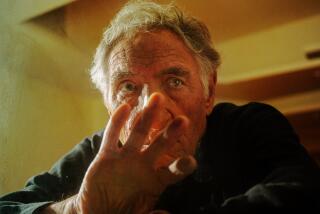You can feel the burn
- Share via
CHRIS McCAW chalks it up to the effects of a late night in the wilderness topped off with a whiskey nightcap. While camping in Utah in 2003, he planned to make an all-night exposure of the night sky. Using a 7-by-17-inch homemade view camera, he hoped to capture Earth’s rotation, tracing the path of the stars. The key was to close the shutter before sunrise. “Well, I woke up a little late,” he admits. “The camera was positioned due east, focused on infinity.”
In short: “The lens effectively becomes a magnifying glass. Sort of like a kid and a leaf,” he says. “When I was changing the film, I saw that it had solarized into a positive image” -- the sun so hot it burned a “path,” an actual hole -- onto the film plane. Later, he made a contact print from the negative. But in the translation, “I lost everything -- the scorching. Instead you got a black line.”
McCaw sat on his breakthrough for a couple of years -- until he could unlock the right combination of exposure, negative, subject and process. His exhibition “Sunburns,” at the Duncan Miller Gallery through June 14, highlights the fruit of his meticulous five-year exploration. The results are stark, incandescent, otherworldly and seem to exist out of time.
Much of what’s on view, says McCaw, who lives and works in San Francisco as a custom platinum/palladium printer, was about perfecting a process that has been elusive. Although he liked the subtleties of his early images, he realized that after making a print, he was in essence destroying the evidence -- the burn in the actual film surface. McCaw began experimenting with fiber-based photo paper, which creates a one-of-a-kind paper negative that, depending on the weather, singes the paper -- sometimes burning right through.
What emerges is an impressionistic rendering of the subject being photographed -- a blur of cactus, a calm sea -- oftentimes with the path of the sun crossing through it. But there’s more to this than just a “smoke-filled camera.” Making these images, says McCaw, “takes the ideas of what photography is all about to a very primal level. The sun is both the subject of the image and an active participant in the printing process. It goes back to the basics of what photography is: Writing with light.”
--
-- Lynell George
More to Read
The biggest entertainment stories
Get our big stories about Hollywood, film, television, music, arts, culture and more right in your inbox as soon as they publish.
You may occasionally receive promotional content from the Los Angeles Times.










